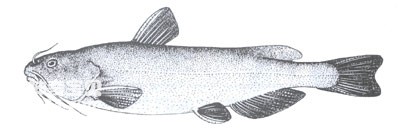Pseudobagrus medialis belongs to the order Pseudobagrus, the family Pseudobagrus, and the genus Pseudobagrus. Commonly known as: bent wire. English name: Dianchi bullhead, Dianchi lake bullhead.
Endangerment level: Endangered. IUCN(1996)EN.
The body is long, the curvature of the dorsal fin is gentle, about the same as the ventral edge, the dorsal fin gradually becomes flattened in front, and then gradually flattened laterally. The head is broad, flat and flat. The muzzle is round and blunt. Mouth wide, inferior, transversely cleft. There are teeth in both jaws, plow and palatine bones. The posterior nasal barbel reaches the posterior edge of the eye; the maxillary barbel reaches about the pectoral fin; the front barbel of the mandible is short, and the posterior barbel reaches the gill membrane. The gill pores are large and the gill membranes are free. The lateral lines are straight. The body has no scales. The dorsal fin spines have weak serrations; the adipose fin base is slightly shorter than the anal fin base; the anal fin is 13-17; the pectoral fin spines have strong serrations; the pelvic fin slightly reaches the anal fin; the trailing edge of the caudal fin is slightly concave and nearly truncate. The back of the head, including the upper occipital spine, is covered with skin. The body is yellow with 3-4 large black spots and the abdomen is lighter.

Lives in rivers and lakes on the plateau at the northern foot of Nanling Mountains. It is a small and medium-sized carnivorous fish at the bottom.
It is a specialty species of Yunnan and is only distributed in Luquanzhangjiu River and Dianchi Lake in the Pudu River system, a tributary on the south side of the Jinsha River.
In the past, it was a common fish in Dianchi Lake and its lower reaches. Since the 1950s, due to the sudden increase in population, excessive domestic sewage and factory sewage have been discharged into the lake, causing eutrophication of the water body, drastic changes in the ecological environment, and fish being unable to adapt to survive. The large-scale reclamation of lakes for farmland from the late 1950s to the early 1970s further exacerbated the difficulties for fish survival. The number has gradually decreased since 1958, and has become even rarer after 1980. It is now in an endangered state.
animal tags:
We created this article in conjunction with AI technology, then made sure it was fact-checked and edited by a Animals Top editor.